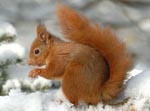The return of the red squirrel?
A project backed by The Prince of Wales is hoping to re-introduce the red squirrel to Cornwall


Michael Galsworthy fondly remembers seeing red squirrels playing on the lawns of Trewithen House in 1953, and when Robin Hanbury-Tenison came to Cornwall in 1960, there were red squirrels on his farm on Bodmin Moor. In his book Wildlife in Cornwall (1970), Rennie Bere noted that ‘small populations of red squirrels are still to be found in several Cornish woods', but observed that they were declining. By 1984, they had disappeared from the county. Now, however, there are red squirrels back in Cornwall, with populations at Mr Galsworthy's estate near Truro and at Paradise Park, Hayle. This time, they're in enclosures, designed to keep them away from the grey squirrels now common in the county. The two females at Trewithen are from the Welsh Mountain Zoo and a male kit (young) joined them recently from Paradise Park.
All three squirrels are part of the National Stud Book, and it's hoped their young will be released into the wild as part of the Cornwall Red Squirrel Project (CRSP). Someone who has been watching the Trewithen breeding population with particular interest is The Prince of Wales, who released the young male into the Trewithen enclosure on July 2. According to CRSP project coordinator Natasha Collings, the native red squirrel had been ousted by the introduction of the hugely successful grey squirrel. Brought into the UK from North America as an ornamental species in 1876 and released onto an estate near Exeter in 1915, the grey squirrel spread rapidly, reaching Cornwall soon after.
The newcomers carry the squirrel-pox virus, which is fatal to red squirrels without causing any symptoms in the grey carriers and, being larger, more robust and able to eat a wider range of foods, greys compete more successfully. The UK population of red squirrels stands at about 120,000 individuals, but there are estimated to be between three and five million greys.
* Country Life Summer Subscriptions Sale - Save £55 a year!
As well as being responsible for the loss of red squirrels, the grey also predates bird eggs and causes extensive damage to trees by stripping bark to reach the sweet-tasting sap beneath. Indeed, the Trewithen estate originally became involved in the CRSP because it lost an entire 3.8-acre plot of newly planted woodland to grey-squirrel damage in 2003. The Red Squirrel Survival Trust (RSST) and associated groups work hard to conserve the species. One success story has been on Anglesey, where, in 1997, the red-squirrel population had plummeted to just 40 adults. A cull of grey squirrels commenced in 1998, and, today, the population of reds on the island stands at more than 400.
Since 2008, red squirrels have been crossing back to the mainland, where they have now colonised several woodlands in Gwynnedd, Wales. This prompted Prince Charles, president of the RSST , to suggest that a red-squirrel reintroduction project be set up in Cornwall, and, in 2009, the CRSP was born. Due to its relative isolation from the mainland and the presence of wooded valleys and mixed woodlands that offer perfect red-squirrel habitats, Cornwall is ideally suited to this project.
Two areas-the Lizard Peninsula and West Penwith -have been earmarked for reintroductions. Research has confirmed both localities to have suitable red-squirrel habitat and both areas are bounded by the sea on three sides and so are more easily defended against repopulation by greys. Miss Collings explains that the grey squirrel needs to be removed from both areas and from an adjoining buffer zone before any red squirrels can be reintroduced because of the squirrel-pox virus they carry. She speaks about the project with infectious enthusiasm, but is realistic. ‘This is a feasibility study. It's a big challenge, but an incredibly exciting project,' she says.
Sign up for the Country Life Newsletter
Exquisite houses, the beauty of Nature, and how to get the most from your life, straight to your inbox.
Mr Hanbury-Tenison, president of the CRSP, is upbeat: ‘I'm delighted with the progress of the project to date.' Who wouldn't welcome walking through a mixed Cornish woodland and seeing red squirrels, perhaps the most charming of British mammals, roaming through the tree tops or even foraging on the woodland floor? If you would like to support the project, visit www.cornwallredsquirrels.co.uk.
** Image courtesy of www.redsquirrelsofthehighlands.co.uk
** Follow Country Life Magazine on Twitter
Country Life is unlike any other magazine: the only glossy weekly on the newsstand and the only magazine that has been guest-edited by HRH The King not once, but twice. It is a celebration of modern rural life and all its diverse joys and pleasures — that was first published in Queen Victoria's Diamond Jubilee year. Our eclectic mixture of witty and informative content — from the most up-to-date property news and commentary and a coveted glimpse inside some of the UK's best houses and gardens, to gardening, the arts and interior design, written by experts in their field — still cannot be found in print or online, anywhere else.
-
 Vertigo at Victoria Falls, a sunset surrounded by lions and swimming in the Nile: A journey from Cape Town to Cairo
Vertigo at Victoria Falls, a sunset surrounded by lions and swimming in the Nile: A journey from Cape Town to CairoWhy do we travel and who inspires us to do so? Chris Wallace went in search of answers on his own epic journey the length of Africa.
By Christopher Wallace
-
 A gorgeous Scottish cottage with contemporary interiors on the bonny banks of the River Tay
A gorgeous Scottish cottage with contemporary interiors on the bonny banks of the River TayCarnliath on the edge of Strathtay is a delightful family home set in sensational scenery.
By James Fisher